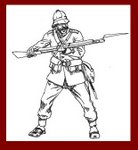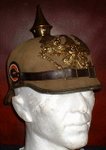
By Doug Johnson (Originally appeared in Soldiers Of The Queen, No. 3)
The khaki uniform, as everyone knows, was introduced in India and used there extensively long before gaining acceptance as regular field dress for the British Army. Some form of drab made brief appearances in South Africa and the Ashanti War but the Sudan campaigns of 1884-85 were the first campaigns outside India where entire forces were outfitted in khaki. The Sudan was also the last place where the red coat was worn in battle.
The red coat had been symbolic of the British Army to Britons and foreigners alike for nearly two centuries. It is understandable that it was abandoned as a battle dress only with great reluctance. The argument for its retention in the Sudan, that it would "Impress the natives", is more indicative of the Victorians' concept of themselves than that of the "native mind". At no time did the red coat exercise the same effect on the Sudanese Imagination as it did on the British.
The British troops that defeated Arabi's army in Egypt still wore red. Khaki drill had already been introduced to British troops serving in India, Aden, and Malta, and was soon Introduced to the army of occupation in Egypt. Thus it was that the first Suakin expedition under General Graham in 1884 was outfitted in khaki. Those staff officers who insisted on wearing red coats soon found themselves favored targets for Mahdist snipers.
The reckless charges of Uthman Diqna's Hadendowa warriors caused many casualties in unexpected hand-to-hand fighting. Some thought they had found the reason for the fervor of these charges when reports filtered in that the Mahdists had thought the drab-uniformed, white-skinned British were just more of the white-coated Egyptians they were in the habit of defeating so easily. In the campaign of 1885, then, it was thought that if the troops marched out in red coats the Mahdists would know that they were fighting British soldiers and their morale and enthusiasm would drop. Many units disembarked in red and some marched out on their first patrols In red. However, the red coat was unsuitable for the Sudanese climate. The Sudanese knew, from their earlier experience, who they were fighting, and only their tactics, not their morale, changed. The red coat was soon discarded and all troops were issued khaki.
Nevertheless the red coat did have a morale effect on the British soldier. He fought just as well no matter how dressed but the red coat was still a symbol that brought forth feelings of pride and patriotism. When the New South Wales contingent disembarked at Suakin in red coats they were met with great cheers, and their red coats were admired and commented on by soldiers and press alike. But the Australians, too, were issued khaki on the very day they arrived, and never wore their red coats into battle. Red was almost entirely absent in the Desert Column. The Guard Camel Regiment was issued red coats in England, but these were replaced by gray as soon as the Guards reached Egypt. The red coat was reserved for church parades. Only one officer wore his red coat, and he fell to a sniper's bullet. The British command was much too influenced by Gordon's claim that the appearance of even twenty red coats in Khartoum would be enough to demoralize the Mahdist army and end the siege. Thus when the Desert Column finally did reach the Nile and met two of Gordon's steamers, red coats were scrounged from the Guards to be worn by the small detachment of the Sussex Regiment sent up the Nile to relieve Khartoum.
Gordon's grasp of "the native mind" was not as firm as the authorities and the public believed. In all probability his statement was supposed to mean that the arrival of a small detachment of British as opposed to Egyptian troops would let the Mahdists know that Khartoum had not been abandoned. But the public took his stated faith in the red coat quite literally, and it is surprising to note how many 20th Century writers retain this same faith when writing of the Sudan, and do not question the literal application of Gordon's claim. The Sudanese had never met a British army, red coated or otherwise, before 1884 and were ignorant of what the British public expected of them at their first sight of red. The arrival of the drab-coated Desert Column at Metemma hastened the fall of Khartoum, and the riflemen and artillerists who kept up a hot fire on Wilson's two steamers seemed more affected by the blue jacket's Gardner gun than the red coats' Martinl-Henrys.
Only one battle, Kirbekan, was fought by the Nile Column, and this was after they had received the news of the fall of Khartoum. The infantry at Kirbekan donned red. Far from being demoralized at the sight of this new uniform, the Mahdists, it was reported after the battle, first mistook the advancing British soldiers for a herd of red cattle! It was only after they were outflanked and attacked from the pear that the Mahdists' morale broke. With the end of the campaign the British withdrew to Egypt in a variety of patched khaki and gray clothing. The Nile Column was disbanded but a small detachment of Egyptian and British soldiers were kept in small outposts along the Nile and the railway line on the frontier. They were followed and harassed by the Mahdists, a vanguard of an invasion that was called off after the Mahdi died.
Between June and December 1885 the border war consisted of attacks on the Angle-Egyptian forts followed by counter-raids. A large Mahdist contingent gathered at the village of Ginnis near Fort Kosheh on the Nile in November. For over a month they harried the garrison which consisted of the Cameron Highlanders and the IXth Sudanese. To bring this frontier war to a conclusion, an Angle-Egyptian force was sent to Kosheh and on 30th December routed the Mahdist Army at Ginnis. Ginnis was a small affair. It is important mainly because it brought the 1885 war to an end but it is remembered as being the last battle in which the British army wore red. The Mahdists were taken completely by surprise, but not by the traditional uniform. They were not aware that reinforcements had come and has made no preparations to meet them. Curiously enough, Ginnis was not the last time red was worn in the Sudan. In1896, when the reconquest of Dongala began, the Egyptian army had no Maxim batteries of its own. A battery from the Connaught Rangers was lent to them, and these men elected to fight the battle of Firka in full dress, red coats and all. Like the use of red coats on the Nile steamers, at Kirbekan and Ginnis, it was a gesture of pride - "showing the colors." The men must have suffered in their red serge but one can imagine that it was a suffering they endured willingly while operating their guns.
Later, after the Battle of Omdurman, the "Bird's Eye View" prints offered to the public by G. W. Bacon and Co. showed the troops in their red "home" uniforms. The company later explaining that this aided with the identification of individual units. As the only identifying marks on the uniforms were standardized facings of blue or white, or kilt tartans which do not show up clearly in the prints, the real explanation is probably that a picture of a "thin red line" was still more pleasing to the public than a khaki smudge. In this way a compromise was made. The red coat was put back in the Sudan in the public's mind, but the soldiers did not have to suffer wearing them.





















































